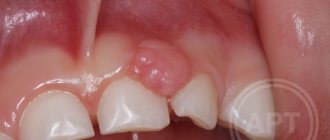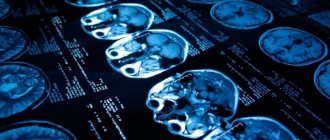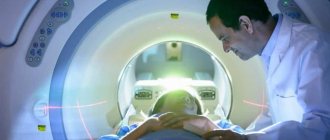Epilepsy in newborns and children under one year of age manifests itself somewhat differently than in adults.
Often parents do not notice alarming symptoms, perceiving them as features of infant behavior.
In addition, seizures are not always of an epileptic nature. Therefore, it is important to carefully examine the baby; the experienced eye of a doctor will always notice the characteristic signs of epilepsy in an infant.
Causes
According to medical statistics, epilepsy in infancy is much more common than in adults.
This is explained by the immaturity of brain structures, so the brain is sensitive to any irritants and reacts by increasing convulsive activity.
The positive point here is that in 70% of those affected during puberty, attacks disappear as the brain reaches its maturity.
The main causes of epilepsy in newborns:
- Hereditary factor. It has been proven that a child whose parents are sick has a higher risk of inheriting a tendency to pathology.
- Birth injury . The risk increases with prolonged labor, the use of vacuum extraction, and entanglement of the umbilical cord. If the mother has a narrow pelvis, the baby's head is compressed during birth and the brain may be damaged.
- Neuroinfections . Diseases such as meningitis, encephalitis, and influenza are very dangerous for a fragile child’s body. Seizures are often complications of these diseases.
- Head injuries. For a child, any bruise can become an impetus for the development of serious pathologies.
- Underdevelopment of the brain. Seizures occur especially often in premature babies.
- Genetic diseases in which chromosomal pathology is observed (Down disease).
- Idiopathic causes. A baby is born with a lack of dopamine, which is responsible for regulating the processes of excitation and inhibition.
Benign myoclonic epilepsy of infancy
DMEM is diagnosed between 6 months and 3 years of age. The child's development is normal until the first myoclonic seizures appear. Approximately 20% of children present with rare seizures at birth or during the neonatal period. The patient's general condition rarely suffers; neurological disorders are not detected. The first myoclonic attacks affect the upper limbs, neck and head, and rarely the legs. They can have different intensities, including in the same child during different episodes. Severity ranges from barely noticeable twitching to visible fibrillation.
The frequency of seizures is 2-3 times a day at different time intervals. There are no long series of attacks observed. It is possible to provoke an attack with a loud sound, tactile or rhythmic light stimulation. After each episode, there may be a refractory period lasting from 20 to 120 seconds. In this time period, even intense stimulation does not cause a new attack. In this case, muscle atony is often observed. The disease is characterized by an intensification of myoclonic attacks when falling asleep (drowsiness) and their disappearance in the slow-wave sleep phase.
There are reflexive and spontaneous variants of DMEM. In the first case, myoclonic seizures develop after exposure to triggers. The spontaneous form occurs without any predictors. In the early stages of the disease and when the intensity of myoclonus is low, parents and pediatricians may mistake attacks for normal motor reactions of the child. Relatively severe myoclonic attacks can be accompanied by tilting the head forward, abductor and adduction movements, bending of the arms, and rarely by smooth rotation of the eyeballs. Often parents note a characteristic “nod” of the head lasting from 1 to 3 seconds, rarely – up to 10 seconds. (in older children). In some cases, the only clinical manifestation of DMEM is prolonged closing of the eyes.
In severe forms, generalization of convulsions is possible, accompanied by loss of balance, sudden loss of objects from hands, and rarely, disorders of consciousness. The process sometimes involves the intercostal muscles, the anterior abdominal wall and the diaphragm, which causes breathing disturbances and an expiratory noise may be heard. DMEM is characterized by an increase in the intensity of clinical manifestations up to a certain age and their subsequent complete disappearance. With a long course of the disease, a lag in psychomotor development is possible. Transformation into other forms of seizures, including absence seizures, does not occur even in the absence of specific treatment.
Risk factors and groups
Provoking factors for the development of epilepsy in newborns are:
- Bad habits of the mother during pregnancy.
- Infectious diseases suffered by the woman (influenza, rubella, mumps).
- Sexually transmitted infections (chlamydia, ureaplasma, syphilis, hepatitis).
- Use of medications during pregnancy.
- Serious chronic diseases of a woman leading to fetal hypoxia (heart disease, kidney dysfunction).
- Long anhydrous period during childbirth.
- Use of general anesthesia for caesarean section.
How it manifests itself: the first symptoms in newborns and children under 1 year of age
How does epilepsy manifest in infants?
The behavior of a newborn child, unlike children 2-3 years old, is accompanied by screams, shudders, and chaotic movements.
Therefore, parents do not immediately notice that the baby is sick. Moreover, attacks often occur during sleep.
Until a child is one year old, the disease manifests itself in small and large epileptic seizures.
Symptoms of minor seizures:
- Freezing in one position.
- Throwing back the head.
- Lack of response to external stimuli.
- A gaze fixed on one point.
- Temperature increase.
- Rolling eyes.
- Nodding head.
Grand mal seizures occur more vividly:
- Sharp stretching of the body.
- The child sharply bends his legs and presses them to his stomach.
- The baby suddenly loses consciousness.
- The child begins to have convulsions and stops breathing.
Night attacks manifest themselves as follows:
- The child suddenly wakes up and screams.
- The baby's face contorts and his torso tenses.
- After an attack, the child may fall asleep silently from fear.
Often such children experience developmental delays, memory impairment, and mental problems.
Parents should always be wary of strange behavior in their infants:
- Constant head nodding.
- Shoulder twitching.
- Sudden freezing.
- Blueness of the nasolabial triangle during feeding.
If such symptoms appear, parents should contact a neurologist; if necessary, the doctor will recommend a consultation with an epileptologist.
Today, doctors consider epilepsy not only as a disease characterized by seizures. Epilepsy is studied as a disease that causes global harm to the entire body, causing a wide range of neuralgic, somatic, mental disorders and changes. Epilepsy most often manifests itself ; the disease can appear in newborns and adolescents. There are many reasons for its occurrence - from congenital factors to the consequences of injuries. Each of them undergoes a thorough analysis to identify the form of epilepsy that they encountered.
Of all people suffering from the disease, epilepsy in children accounts for 70% of the total, so the disease is rightfully recognized as one of the leading diseases in pediatric neurology. It has been scientifically proven that the earlier the problem is diagnosed and treatment is started, the more successful and faster the result is. Since not every parent is able to identify epilepsy in children , adults need to know the main symptoms of the disease, which should alert them and become a good reason for going to the doctor.
Epilepsy in children - diagnosed by a doctor
Parents should refrain from making a diagnosis on their own, even in cases where they are absolutely sure that their child suffers from epilepsy. Moreover, it is unacceptable to independently determine the medications needed to take, despite the fact that their lists and dosage are indicated in specialized literature. To make an accurate diagnosis, you need to visit a specialist neurologist or epileptologist, tell him about the alarming factors, answer the questions in as much detail as possible and undergo the recommended examination.
What reasons most often make one suspect epilepsy in children and become the reason for a visit to the clinic? Among them:
- Sleep disorders - night sleep is the most sensitive indicator of the state of the central nervous system, so disruptions in sleep patterns often signal poor health. If a child takes too long to fall asleep or, on the contrary, wakes up, there is reason to worry. Please note that if the baby tosses and turns for a long time before going to bed, his whole body shudders during the period of falling asleep. When waking up, you should be alert to the child’s confusion, lack of understanding of where he is, and a long time to come to his senses. Often a reason to suspect epilepsy in children is such disorders as constant awakenings, screaming, laughing, crying, talking in their sleep, and sleepwalking. Even if there are no other signs, this is a serious reason to contact a neurologist. Adolescence is characterized by the presence of nightmares, which result in increased sweating and increased heart rate. In the morning, it is difficult for such a child to wake up, it takes him a long time to come to his senses, he is characterized by a lack of vigor, lethargy and a state of chronic fatigue.
- Increased fatigue, disturbances in the memorization process, groundless capriciousness, and distracted attention will help to suspect epilepsy in children
- One should be seriously wary of attacks of causeless lightheadedness, frequent mood swings, and incomprehensible pain throughout the body.
- If your child does not recognize places familiar to him or he often has a feeling of déjà vu, when it seems to him that he has been to a previously unvisited place, then this is also a sign for going to a neurologist.
It must be remembered that epilepsy in children occurs 3 times more often than in adults. If the disease is detected at an early stage, it can be completely cured. Parents do not want to believe until the last moment that it is their child who has encountered the disease, but they should remain calm and try to make every effort to save the child from the insidious disease.
Forms of epilepsy in children
The forms distinguish between symptomatic epilepsy in children , when seizures are caused by structural defects of the brain (hemorrhage, tumor, cyst), idiopathic with a hereditary predisposition to the occurrence of the disease (sometimes after several generations), and cryptogenic - with an unidentified cause of seizures. It is a mistake to believe that epilepsy in children is a death sentence for well-being for the rest of their lives. Today, medicine has reached great heights in the correction of illness. Recovery occurs in 70% of cases. This is especially typical when parents do not delay contacting a doctor, do not try to interfere with the prescribed treatment, and follow all the recommendations of specialists.
Signs of epilepsy in children - what are the types of seizures?
to detect epilepsy in children than in adults. In infants it often resembles simple motor activity. In addition, the disease is not always characterized by convulsive symptoms. And epilepsy does not exist in nature as a single disease. This is a whole complex of diseases with different clinical manifestations, which includes more than 60 types of diseases. All this makes diagnosis difficult in the early stages. However, there are still common symptoms:
Generalized attacks with convulsions are accompanied by short-term interruptions in breathing and sudden tension in the muscle corset. With this form of epilepsy, children experience seizures that last from 10 seconds to 15 minutes. Their duration may vary. During an attack, involuntary urination and defecation may occur, since the sharp relaxation of muscles following the tension creates all the prerequisites for this. After the attack ends, the child falls asleep, so it is very important to give him peace and time for the body to recover naturally.
Generalized seizures without convulsions , otherwise called absence seizures, are not so noticeable. to suspect epilepsy in children with absence seizures, since during an attack the child simply freezes, plunges into a state of thoughtfulness and a short stupor. His gaze becomes empty, sometimes twitching of the eyelids and throwing his head back appear. Trying to attract the child's attention at this moment, you will encounter a complete lack of reaction on his part. This state lasts no more than 20 seconds, so it is often mistaken by parents for ordinary absent-mindedness. At the end of the attack, the baby returns to the interrupted activity, as if nothing distracted him. Absence seizures are characterized by epilepsy in children aged 5-6 years. Moreover, girls are more susceptible to this form of the disease than their peers, boys. This type of disease is recorded in them twice as often. Absence epilepsy continues in children until puberty. Then a hormonal imbalance causes the disease to cease or transition to another form.
An atonic attack is manifested by a sudden loss of consciousness by the child, similar to fainting. If this condition recurs, you should consult a doctor immediately.
Infantile spasms are typical for children 2-3 years old. By the age of five they pass or change into another form. Spasms appear in involuntary movements when the child presses his arms to his chest, tilts his head or body forward, straightens his legs unnaturally. Sometimes the manifestation is expressed in an unnatural and prolonged nodding of the head.
Other signs of the disease may include:
- headaches, which include nausea and vomiting;
- speech disorders, when the child cannot speak for some time;
- nightmares and sleepwalking.
There is no need to sound the alarm if there are single signs indicated above. But if the symptoms recur with a certain frequency, then it is worth contacting a neurologist to rule out epilepsy in the child or confirm the diagnosis and prescribe treatment in a timely manner. The specialist will conduct a visual examination and prescribe electroencephalography, magnetic resonance or computed tomography.
You should undergo tests recommended by your doctor, since one of the signs of epilepsy in children is a lack of certain microelements in the body. This was first stated by neurologist Andre Barbois in 1973. He noted that a lack of zinc and magnesium in the body can provoke a convulsive attack. Even if this disadvantage is only temporary. To diagnose the level of microelements in the blood, it is necessary to undergo tests in a specialized laboratory. Based on them, the doctor can draw appropriate conclusions when prescribing treatment.
Treatment of epilepsy in children - correction methods
It is very important to determine the root cause of epilepsy in children in order to be able to prescribe competent and targeted treatment for the disease. In pharmacology, there are a large number of drugs that have anticonvulsant effects. Each medicine is effective for one form or another of epilepsy. There is no single dosage form that is equally effective for all patients.
Anticonvulsants are most often prescribed when multiple attacks occur, after which immediate results are observed in 30% of cases. In severe forms of the disease, the frequency and intensity of its manifestations decrease. The doctor begins prescribing the drug with a small dose, gradually increasing it if the effect planned by the therapy is not achieved. Parents should be prepared for the fact that epilepsy in children can take several months to several years to treat. You shouldn’t expect a quick cure for the disease; in some cases, it can be present in a person’s life for decades. It is important not to give up and believe in a successful outcome, since the internal state and belief in victory serve as a serious help in activating the body’s defenses.
Diagnosis of the disease in infants
Diagnosis of infantile epilepsy is somewhat difficult. First of all, it is necessary to differentiate true epileptic seizures from increased neuro-reflex excitability. The latter differs in that the movements of the limbs stop if they are held by hands.
To clarify the diagnosis, the following diagnostic methods are required:
- electroencephalogram;
- MRI, CT scan of the brain;
- Ultrasound of the brain.
These studies can detect cysts, neoplasms, hemorrhages, and dropsy.
EEG reveals foci of excitability. It should be carried out during sleep and wakefulness, since convulsive activity can only be recorded during sleep. In addition, it is necessary to conduct a blood test for the levels of glucose, potassium, sodium, magnesium, and protein.
Treatment of illness in children
Treatment of the disease in infants begins with normalizing the daily routine.
The baby should go to bed, wake up, and eat at approximately the same time.
The child should be protected from sharp sounds, flashes of light, and nervous shocks. You need to limit the amount of salt and carbohydrates in your diet.
Doctors are of the opinion that any form of epilepsy should be treated with anticonvulsants. The medicine is selected individually.
Without medication, the disease will progress, and the chances of recovery during adolescence will be significantly reduced.
The following drugs are approved for use in infants:
- Gluferal;
- Convulex;
- Depakine.
Therapy begins with a minimum dosage, gradually increasing.
The duration of treatment ranges from one to three years. At the same time, nootropics (Pantogam) are prescribed. It improves cerebral circulation, eliminates the effects of hypoxia, and prevents cognitive impairment.
Surgical treatment is used if the cause of the attacks is a tumor in the brain.
Symptoms
It is important to know: in newly born babies, seizures are focal in nature, so they are difficult to identify. However, there are manifestations by which this can be done. So, signs of epilepsy in infants include:
- Twitching is involuntary (clonic), appearing in different places (migrating).
- Stopping breathing.
- Movement of the jaw (as if the patient is chewing something).
- The eyes do not react to light or, on the contrary, are pointed at one point.
Most often, these signs of epilepsy in infants appear after a stroke associated with ischemia and (or) hypoxia. In most babies, the central nervous system was affected by infections.
We recommend reading the article: Symptoms and signs of epilepsy
First aid for an attack
Often parents, when faced with a child’s epileptic seizure for the first time, are confused and behave incorrectly.
First aid during an attack:
- Place the child on a horizontal surface.
- Remove all objects that could injure him.
- Turn your head to the side to prevent choking on saliva and tongue sticking.
- You cannot hold the baby, press his arms and legs.
- You should not give water or milk during a seizure, as the baby may choke.
- Monitor your breathing closely.
- After a seizure, let the child sleep.
- If the attack lasts longer than 5 minutes, call an ambulance immediately.










